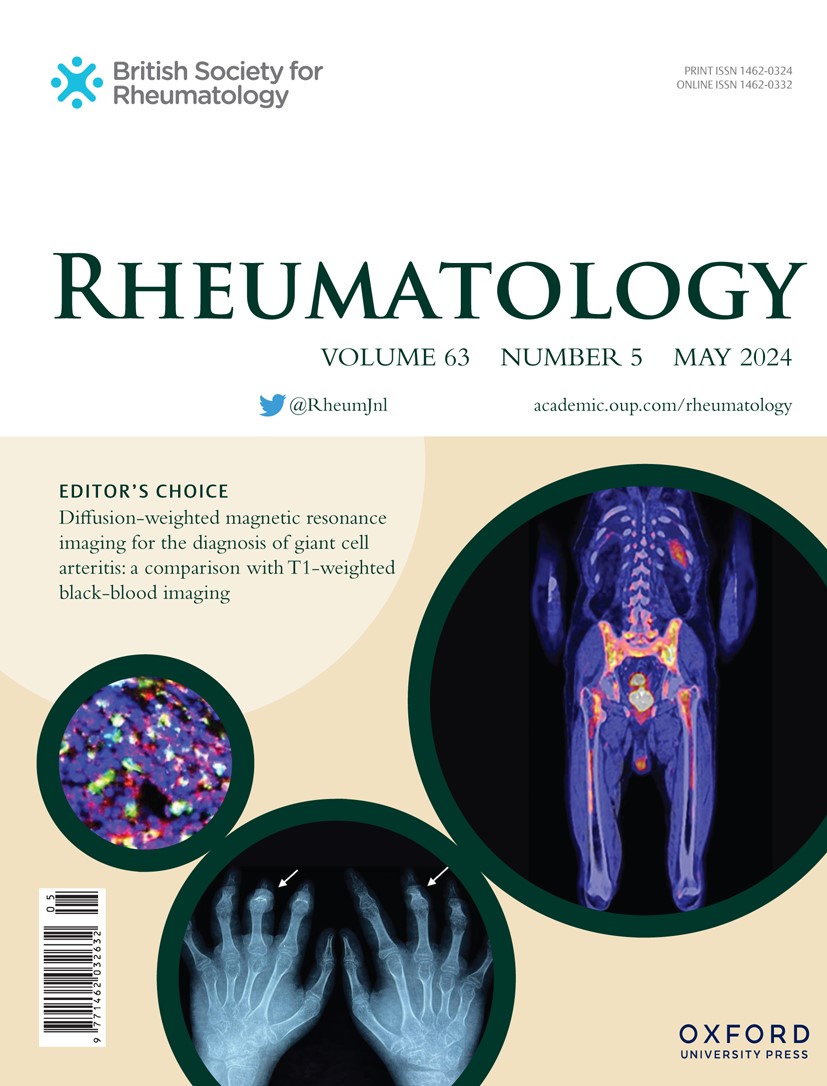身体成分对系统性硬化症患者有影响吗?
IF 4.7
2区 医学
Q1 RHEUMATOLOGY
引用次数: 0
摘要
目的机体成分在各种风湿性和自身炎症性疾病中起重要作用。本研究的目的是评估系统性硬化症(SSc)患者肌肉质量和皮下脂肪组织质量和数量的影响。方法纳入我们三级中心接受高分辨率胸部计算机断层扫描(HRCT)评估肺部受累的成人SSc患者。在第12背椎水平对皮下脂肪和椎旁肌肉进行半自动分割,并收集体成分指标(皮下脂肪和椎旁肌肉面积和密度)。采用逐步线性回归分析来评估身体成分、人口统计学和肺功能测试是否可作为死亡率的预测因子。考虑到肌肉Hu值为&;lt;30的患者受肌骨增生症影响,我们使用风险比来评估其是否与较高的死亡风险相关。结果87例SSc患者(女性77例,年龄60±15岁,61%为局限性皮肤SSc)。线性模型显示,低DLCO (p = 0.047)、高BMI (p = 0.013)、高皮下脂肪密度(p = 0.005)和低骨骼肌指数(p <;0.001)作为死亡率的预测因子。总体而言,63例(72%)患者受到肌骨增生症的影响(即Hu &;lt;CT显示肌肉脂肪浸润患者的死亡风险高3.345倍(95% CI 0.396 ~ 28.295)。结论系统性硬化症患者存在肌骨化症和前期肌肉减少症,体成分可能影响整体预后。本文章由计算机程序翻译,如有差异,请以英文原文为准。
Does body composition matter in patients with systemic sclerosis?
Objectives Body composition plays a significant role in various rheumatic and autoinflammatory diseases. The aim of our study was to assess the impact of muscle mass and subcutaneous adipose tissue quality and quantity in patients with systemic sclerosis (SSc). Methods Adults with SSc referring to our tertiary center who underwent high-resolution chest computed tomography (HRCT) to assess pulmonary involvement were included. A semi-automatic segmentation of the subcutaneous fat and paravertebral muscle was performed at the level of the 12th dorsal vertebra, and body composition metrics were collected (subcutaneous fat and paravertebral muscle area and density). Stepwise linear regression analysis was applied to evaluate if body composition, demographics, and pulmonary function tests acted as predictors of mortality. Considering patients with muscle Hu values <30 as affected by myosteatosis, we used the odds-risk ratio to assess if it is associated with a higher risk of mortality. Results Eighty-seven SSc patients (77 females, age 60±15 years, 61% affected by limited cutaneous SSc) were included. The linear model demonstrated that lower DLCO (p = 0.047), higher BMI (p = 0.013), higher density of the subcutaneous fat (p = 0.005), and lower skeletal-muscle index (p < 0.001) acted as predictors of mortality. Overall, 63 patients (72%) were affected by myosteatosis (ie, Hu < 30 Hu) and patients affected by muscle fat infiltration at CT showed a 3.345 times higher mortality risk (95% CI 0.396–28.295). Conclusion Patients with systemic sclerosis are affected by myosteatosis and pre-sarcopenia and body composition seems to influence the overall outcome.
求助全文
通过发布文献求助,成功后即可免费获取论文全文。
去求助
来源期刊

Rheumatology
医学-风湿病学
CiteScore
9.40
自引率
7.30%
发文量
1091
审稿时长
2 months
期刊介绍:
Rheumatology strives to support research and discovery by publishing the highest quality original scientific papers with a focus on basic, clinical and translational research. The journal’s subject areas cover a wide range of paediatric and adult rheumatological conditions from an international perspective. It is an official journal of the British Society for Rheumatology, published by Oxford University Press.
Rheumatology publishes original articles, reviews, editorials, guidelines, concise reports, meta-analyses, original case reports, clinical vignettes, letters and matters arising from published material. The journal takes pride in serving the global rheumatology community, with a focus on high societal impact in the form of podcasts, videos and extended social media presence, and utilizing metrics such as Altmetric. Keep up to date by following the journal on Twitter @RheumJnl.
 求助内容:
求助内容: 应助结果提醒方式:
应助结果提醒方式:


